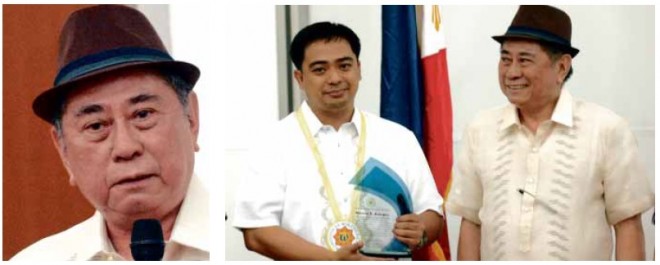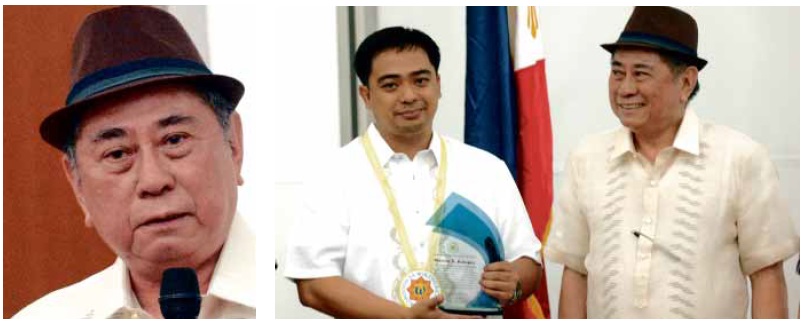
MANILA, Philippines—The National language is once again in the news, but this time the controversy is over a single letter: whether we should use Filipinas or Pilipinas as the country’s official name.
There was no letter F in the Tagalog alphabet when President Manuel L. Quezon proclaimed it as the basis for the national language on Dec. 30, 1937, although the sound it represented existed in other languages in Northern and Southern Philippines.
However, as the national language develops, it is enriched by other languages native and foreign, so the growth of the alphabet naturally follows—and that’s how National Artist for Literature Virgilio S. Almario insists it should be.
Expectedly, on the frontline battling it out with politicians is the Komisyon sa Wikang Filipino (Commission on the Filipino Language). To strengthen its stand, it recently held Kapihang Wika at the Main Library of University of the Philippines in Diliman and laid out its long-range plans for the year.
This was underscored by the153rd death anniversary on Feb. 20 of Francisco Baltazar, aka Balagtas, the Prince of Tagalog Poets, our Shakespeare.
Poster girl
Meanwhile, KWF has found an unlikely poster girl in Vilma Santos, declaring: “Ako ay Filipino. Filipino ang wika ko. Filipinas ang bayan ko.”
Why the Star for All Seasons? Why not the Superstar, who’s more identified with the masses?
“We were waiting for Nora [Aunor], but Vilma endorsed first,” says Almario, who heads KWF.
He says they do not call for the prohibition of the use of P for the country’s name spelling, though.
“Wala namang bawal,” he clarifies. “We just encourage people to use Filipinas more. We’re waiting for the senators to file a bill.”
Grimmer issue
A grimmer issue KWF has to face is with Commission on Higher Education chair Patricia B. Licuanan’s statement last Nov. 27 that it would stand by CHEd Memorandum No. 20, Series of 2013, which would remove Filipino from its General Education Curriculum and limit its teaching in college to Filipino majors and Education in Filipino majors.
Almario points out this would mean thousands of teachers in colleges and universities losing their jobs by 2016 (estimated at over 10,000 full-time and 20,000 part-time Filipino professors).
In his Dec. 19 letter to CHEd, Almario asked that it support the national language and the right to security of tenure of teachers who might be affected by its move. He also asked CHEd what concrete steps it would take to carry out the 1987 Constitution’s mandate to propagate Filipino and use it as language of instruction in colleges and universities.
Show of force
The Kapihang Wika at UP on Jan. 28 appeared to be a concretization of those concerns, a show of force, as it were. It was graced by eminent writers such as Almario, Roger Mangahas, Marne Kilates, Roberto Añonuevo, tri-media representatives, students and teachers.
Purificacion G. Delima, commissioner for programs and projects, analyzed KWF’s researches on its forthcoming linguistic atlas, the Atlas Filipinas. The panel discussion that followed, chiefly consisting of Q&A, ran for nearly two hours.
Laid out was the KWF calendar of events and activities for the year, also covering regional languages and ranging from conferences (Kumperensiya sa Wika at Panitikang Waray) to writing competitions (Timpalak Uswag Darepdep).
The gathering was capped by the awarding of the 1st Gawad Julian Cruz Balmaseda, named after the preeminent writer. The award is for an academic work of considerable length written in Filipino.
Compleat writer
Balmaseda was someone one would call the compleat writer. Writing in Tagalog, English and Spanish, he excelled as playwright (“Sa Bunganga ng Pating,” “Ang Palabas ni Suwan,” “Sangkuwaltang Abaka,” “Ang Piso ni Anita,” “Higanti ng Patay”); poet (“Sa Bayan ni Plaridel,” “Anak ni Eba,” “Ale, Aleng Namamayong”); critic and literary historian (“Ang Tatlong Panahon ng Tulang Tagalog”); fictionist (“Sa Pinto ng Langit,” “Ligayang Nawawala”); journalist and essayist (“Budhi ng Manggagawa,” “Dugo ng Aking Ama”).
He was also leader of a writers’ union and director of Surian ng Wikang Pambansa (Institute for National Language, the precursor of KWF established in 1937).
Born on Jan. 28, 1885, in Udyong (now Orion), Bataan, Balmaseda settled with his family in Cavite. He died on Sept. 18, 1947. The award was given in time for his 120th birth anniversary.
The first recipient was Marlon S. Delupio, for his 900-page PhD History dissertation at De La Salle University: “Kasaysayang Pangkalinangan ng Isang Kilusang Panlipunan, 1930-38,” in which he explores the Sakdalista independence movement during the Commonwealth era.
First Tagalog poet
In his speech at the awarding ceremony, Almario acknowledged his debt to Balmaseda in enlightening him on the dark pages in the development of Tagalog poetics, that is, from 1600 to Balagtas.
It was Balmaseda’s 1938 book of literary history, he said, that prodded him to seek the work of Pelipe de Jesus (spelled with an initial P in the old text), considered the first Tagalog poet with “poetic sense” for employing “not only rhetorical words and phrases but also figures of speech and allusions.”
Almario recounted his travails in tracking down a tattered copy of De Jesus’ versification of the legend of Barlaam and Josaphat, “Dalit na Pamucao sa Balang Babasa Nitong Libro,” an awit (narrative poem) of 46 octosyllabic quatrains based on the 553-page Spanish novel translated into Tagalog by Jesuit missionary Antonio de Borja and published in 1712, the first novel to be printed in the country.
Language purism
As concluding part of the program, a Balmaseda descendant was called to speak. José Ma. P. Balmaceda (with a C), dean of the UP College of Science, sheepishly remarked he could claim to only eight out of nine letters of the revered surname.
He marveled at how the national language had grown, pointing out to books of math and sciences that could now be written in Filipino. He took issue, however, with Tagalog purists creating an artificial language of clumsy coinages and laughable compound words, thereby limiting the language instead of enriching it, which should be its natural course.
Almario says KWF is undertaking major activities the whole year round. Among them is Kampo ni Balagtas, a youth camp to be held at Orion Elementary School on March 30-31. Born in Bigaa, Bulacan, Balagtas had lived in Tondo and Pandacan, started a family in Balanga, settled and continued writing in Orion, where he died.
On March 30, a cultural park will be opened there. Hardin ni Balagtas has a statuary of the poet and characters from his works, surrounded by indigenous trees and flowers.
Anticipated event
A much-anticipated event is the 52nd Talaang Ginto, the poetry competition of original poems in Filipino with verses not less than 40 lines. This year’s theme is “Si Balagtas at ang Kabataan” (Balagtas and the Youth).
Deadline for submission of entries is on Feb. 27. The winner will be declared Makata ng Taon on April 2, Araw ni Balagtas, in commemoration of his 217th birth anniversary.
This may assure lastingness of the national language, but still it is rather disturbing. We’re probably the only country on earth to annually hold something like Linggo ng Wikang Pambansa (National Language Week, sometime in August)—which doesn’t speak very well of us as a nation.
Komisyon sa Wikang Filipino holds office at 2/F, Watson Bldg., 1610 JP Laurel St., Malacañang Complex, San Miguel, Manila. Call 7362519; visit www.kwf.gov.ph.









































